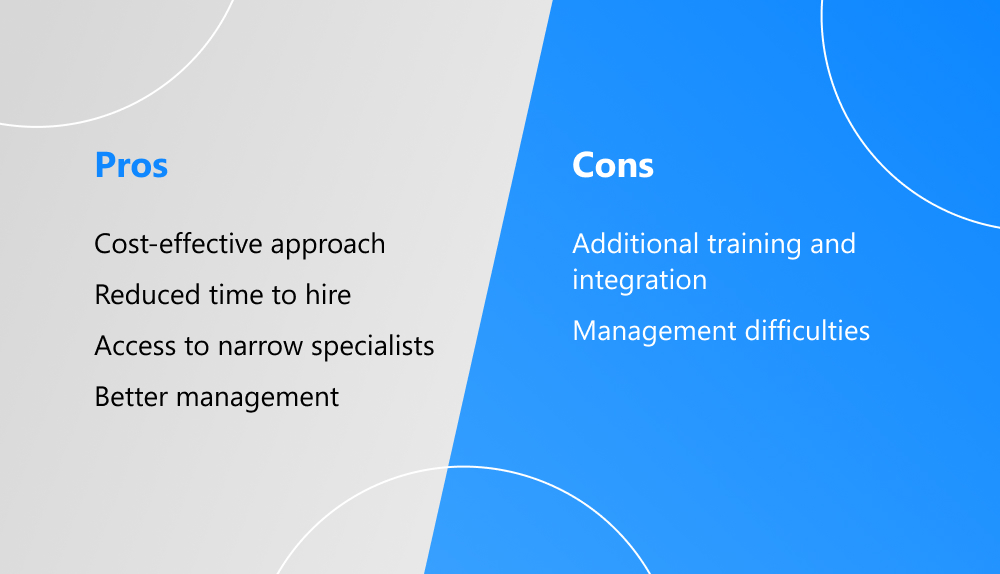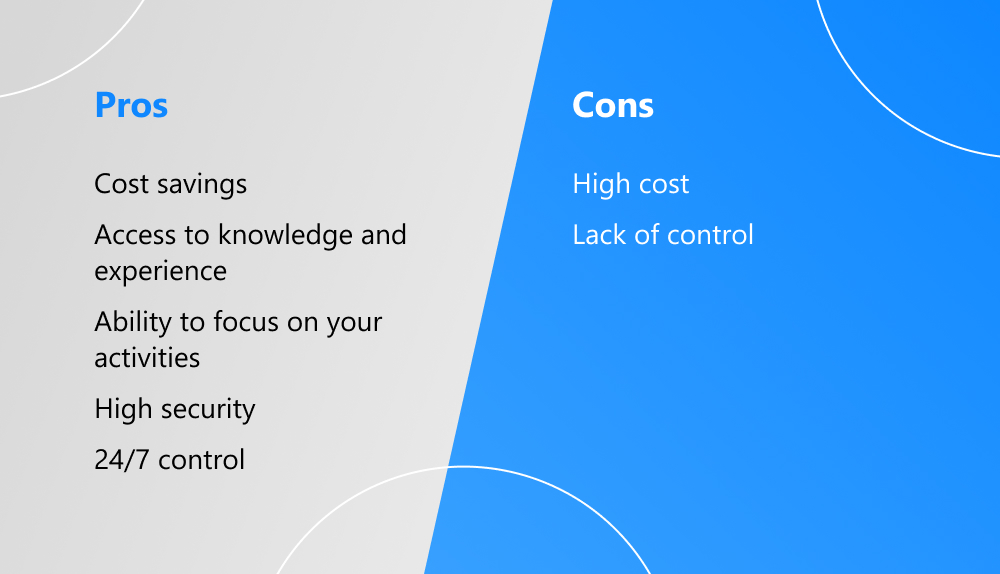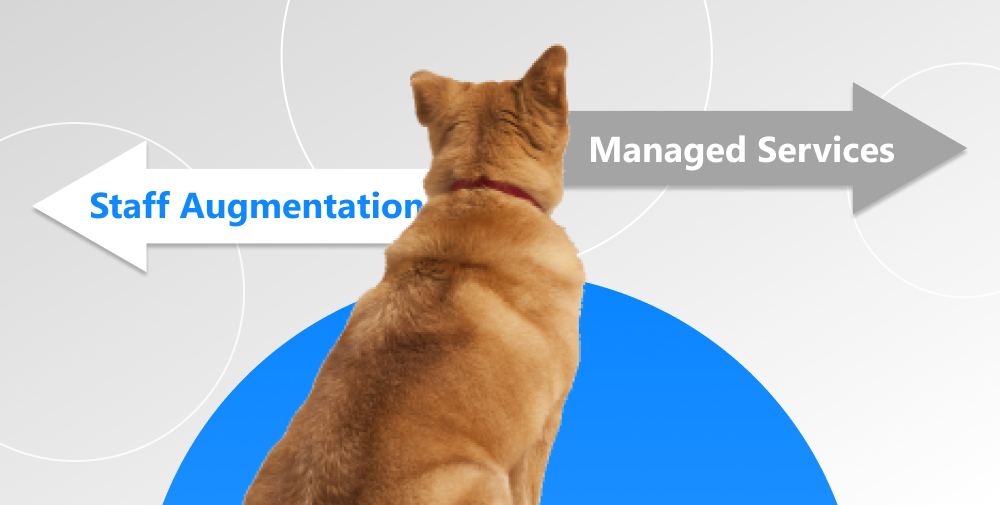Staff augmentation vs managed services: what approach should choose the company that is aimed at successfully developing its business, meeting customer requirements, and withstanding high competition in the market? To deal effectively with all of these issues, you need experienced and skilled employees focused on their roles and responsibilities. However, it's not easy to find the right specialists in the short term. Hiring an in-house team is costly, time-consuming, and resource-intensive.
Therefore, companies are looking for new, flexible personnel solutions that make it possible to save money, time, and labor costs. There are various cooperation models today, the popular of which are staff augmentation and managed services. Let's compare the advantages and disadvantages of every approach and find out which one is best for your business.
written by:
Alexander Arabey
Director of Business Development, Qulix Systems
Staff augmentation vs managed services: what approach should choose the company that is aimed at successfully developing its business, meeting customer requirements, and withstanding high competition in the market? To deal effectively with all of these issues, you need experienced and skilled employees focused on their roles and responsibilities. However, it's not easy to find the right specialists in the short term. Hiring an in-house team is costly, time-consuming, and resource-intensive.
Contents
Staff Augmentation: Reinforcing Your Team
It's a collaboration model where an organization hires external specialists on a temporary basis to improve project efficiency. Simply put, you can quickly recruit employees for a particular project if you lack certain professionals. This approach will allow you to minimize the costs associated with hiring and project management.
Advantages for Your Business
Cost-effective approach
Maintaining your own staff includes many expenses, such as equipment, insurance, taxes, and much more. For example, an organization must pay from $62.5k to $70k per year including taxes in the USA so that an employee will receive $50k per year. By expanding your team, you will be able to save on operating costs by using human resources in the same way as if there were in-house employees.
In addition, you do not have to spend money on employee recruitment. Look at LinkedIn, one of the most popular job search websites. LinkedIn advertising costs $5.26 per click nowadays. Since it usually takes 44 days to hire a new employee in the IT industry, finding a required professional will cost a bundle. The staff augmentation model allows you to significantly save on the hiring process because you will get your specialist in a quick period of time without any job ads.
Reduced time to hire
As stated above, recruiting is a long and difficult process; and the current circumstances don't allow companies to spend weeks and even months on it. While you are looking for the right specialist, your competitors will launch their project and skim all the cream off the cake.
Access to narrow specialists
This model effectively solves the problem of a shortage of specialists with vast experience and expertise in certain areas or technologies. It may also happen that you need a narrow specialist until your work on the project or product. In this case, staff augmentation will allow you to quickly resolve this issue, making the hiring process flexible and easy. Add the necessary specialists when you need them and remove them when their support is no longer needed.
Better management
When choosing a staff augmentation operating model, you don't have to worry about control over the project since the external team will directly work with the internal personnel. The augmented staff will fulfill the requirements and tasks of your project manager. Basically, you get almost in-house employees except that you don't have to puzzle over some of the organizational issues and expenses associated with maintaining an internal team.
Disadvantages to Consider
Additional training and integration
Although the external team will have all the necessary skills and experience, it will take time for them to become familiar with the new colleagues, project requirements, internal processes, and company policies. By the way, a new employer needs 90 days to be fully integrated into the company and bring value.
Management difficulties
When hiring an external team, your project managers should be prepared to manage more people, provide additional guidance, and so on.
Now, let's look at another model and speak about managed services vs staff augmentation.
Managed IT Services: Guarding Your Business
The managed services market is expected to grow to $354.8 billion by 2026 from $242.9 billion in 2021, according to MarketsandMarkets. The popularity of this approach is explained by the fact that companies, which have no funds to maintain full-time IT specialists and equipment, get an opportunity to use enterprise-class services for a predictable monthly fee and without significant initial investment. They pay only for the services they need at the moment, which allows them to considerably reduce costs and optimize their IT investments.
Managed services is an outsourcing model where a company transfers its IT systems or assets to the management of another company, known as a managed services provider or MSP. It is responsible for managing these assets, ensuring their efficiency, controlling business performance, monitoring, reporting, and much more. At the same time, the service provider can manage the entire IT infrastructure or separate services. You can conclude a Service Level Agreement or SLA, and sleep well because your partner will solve all the problems related to maintaining IT systems, deploying new infrastructure, migrating services, and so on.
What Benefits Will You Get?
Cost savings
You pay only for the services that you will use. You don't need to spend huge sums on IT infrastructure maintenance and IT staff. You do not need to spend months looking for the right specialists as the managed services model will provide you with professionals with the necessary competencies. You will be able to plan your budget as you will be transferring a fixed amount to the service provider on a monthly basis. Depending on the needs of your business, you can optimize costs by removing or replacing unnecessary services.
Access to knowledge and experience
Managed services provide access to skilled professionals releasing you of the need to find or hire them by yourself. Staff onboarding and training won't be your headache, either.
Ability to focus on your activities
While the MSP is in charge of maintaining the IT infrastructure and solving related tasks, you and your employees will be able to devote your energy to growing your business. With managed services, you will find it easy to implement new technologies, bring new products to market, and change business processes. This usually requires companies to rebuild or scale the infrastructure, which is time-consuming. This model will allow you to make changes several times faster, without losing any profit or customers.
High security
The vendor places equipment and computing power in secure data centers to ensure the safety of your data and protection from hacker attacks. Managed services providers care about their reputation and use the latest security standards and equipment from leading suppliers, such as Cisco Systems, Dell, VMware, and so on.
24/7 control
MSPs monitor hardware and applications, anticipate and correct failures, and perform backup and recovery as needed on a 24-hour basis. Their task is to ensure the continuous functioning of the infrastructure and to solve problems immediately.
Take Note of Some Drawbacks
High cost
It's true that managed services allow businesses to significantly save on infrastructure and gain access to the latest technologies, but the services of a good and reliable vendor will never be cheap. Staff augmentation will cost you less, although everything depends on your needs.
Lack of control
Your internal team knows all the nuances and processes of your business, its pain points and problems, while the provider will only deal with its own scope of work. You will be completely in charge of your team, while your partner will be fully responsible for its part. Therefore, you need to choose a reliable service provider that is capable of taking care of your company.
Staff Augmentation vs Managed Services: What Does Your Business Need?
So, which is better: managed services or staff augmentation? There is no clear answer to this question as both approaches have their pros and cons. Every software development company has its own needs and resources. That's why there are several outsourcing models that they can use to get the best possible outcome.
Staff augmentation allows your company to take advantage of the knowledge and competencies of the best IT specialists without spending a lot of time and money on finding and hiring them. These employees will work exclusively on your project, using their experience gained in a particular area. They will integrate with your internal team and become part of your business. Thus, you can build your development team according to the needs of your project and scale it up or down in the future depending on your business goals.
This flexible solution is best suited for existing projects. You can add additional employees at certain stages of the project and quickly remove them. You retain control over proven specialists, but get rid of the necessity to solve financial and administrative issues. Are you looking for people for a specific task? Then this approach is ideal for you.
If you don't have an IT team maintaining your networks and infrastructure, and you don't mind transferring direct control over them to an external team, choose managed services. This model is perfect for i) large companies that want to unload their specialists and send them to solve other business problems; ii) small and medium-sized businesses that do not have the funds and resources to maintain their own infrastructure and gather their own team; iii) startups that want test and launch their products without hiring particular specialists.
Do you still have doubts or concerns about staff augmentation or managed services? Can't choose between two models? Don't hesitate to get advice from our specialists. Tell us about your project, requirements, goals, budget, and time limits, and our experts will help you select the most convenient and profitable model for you. For more detail, please visit our website or get in touch with our support team.

Contacts
Feel free to get in touch with us! Use this contact form for an ASAP response.
Call us at +44 151 528 8015
E-mail us at request@qulix.com










